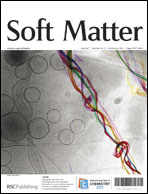Due to their expanded coil to collapsed globule transition close to physiological temperatures, N-isopropylacrylamide (NIPAAM) polymers and derivatives thereof represent promising drug delivery vectors. Here, we report on the interaction between anionic PNIPAAM derivatives containing potassium 3-sulfopropylmethacrylate (SPMA) blocks of various sizes and a cationic lipid membrane mimic as a function of temperature, polymer charge density and molecular weight, by injection under a pre-compressed surfactant monolayer. The resulting film properties (including equilibria) were studied using surface pressure–area isotherms, Brewster angle microscopy, and interfacial 2D oscillatory rheology. Whereas mixed films of dioctadecyldimethylammonium bromide (DODAB) and an uncharged PNIPAAM homopolymer resulted in distinct polymer and surfactant domains, the anionic polyelectrolytes were found to ionically cross-link and contract the DODAB film. Film penetration, charge screening and surfactant film contraction were dependent on the molecular weight and size of the SPMA blocks on the polymers.

You have access to this article
 Please wait while we load your content...
Something went wrong. Try again?
Please wait while we load your content...
Something went wrong. Try again?


 Please wait while we load your content...
Please wait while we load your content...